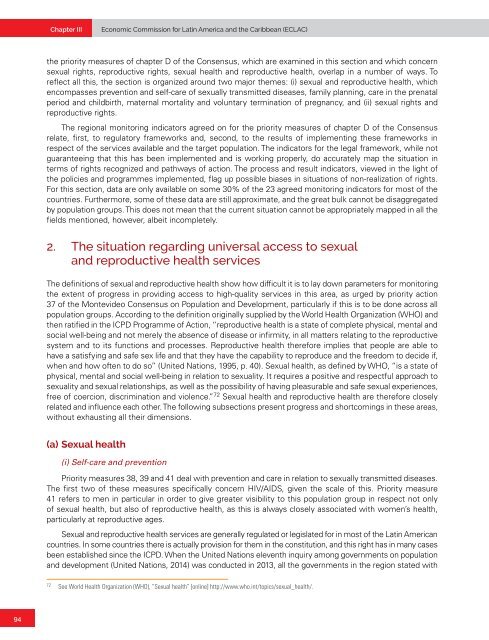Draft first regional report on the implementation of the Montevideo Consensus on Population and Development
This draft report seeks to give an account of progress in the implementation of the priority measures of the Montevideo Consensus on Population and Development in the region, as well as the differences between countries in terms of the degree of implementation. By highlighting relevant national experiences, it also seeks to facilitate the exchange of good practices among countries so that they can benefit from each other in their efforts to advance the implementation of the actions of the Montevideo Consensus.
This draft report seeks to give an account of progress in the implementation of the priority measures of the Montevideo Consensus on Population and Development in the region, as well as the differences between countries in terms of the degree of implementation. By highlighting relevant national experiences, it also seeks to facilitate the exchange of good practices among countries so that they can benefit from each other in their efforts to advance the implementation of the actions of the Montevideo Consensus.
You also want an ePaper? Increase the reach of your titles
YUMPU automatically turns print PDFs into web optimized ePapers that Google loves.
Chapter III<br />
Ec<strong>on</strong>omic Commissi<strong>on</strong> for Latin America <strong>and</strong> <strong>the</strong> Caribbean (ECLAC)<br />
<strong>the</strong> priority measures <strong>of</strong> chapter D <strong>of</strong> <strong>the</strong> C<strong>on</strong>sensus, which are examined in this secti<strong>on</strong> <strong>and</strong> which c<strong>on</strong>cern<br />
sexual rights, reproductive rights, sexual health <strong>and</strong> reproductive health, overlap in a number <strong>of</strong> ways. To<br />
reflect all this, <strong>the</strong> secti<strong>on</strong> is organized around two major <strong>the</strong>mes: (i) sexual <strong>and</strong> reproductive health, which<br />
encompasses preventi<strong>on</strong> <strong>and</strong> self-care <strong>of</strong> sexually transmitted diseases, family planning, care in <strong>the</strong> prenatal<br />
period <strong>and</strong> childbirth, maternal mortality <strong>and</strong> voluntary terminati<strong>on</strong> <strong>of</strong> pregnancy, <strong>and</strong> (ii) sexual rights <strong>and</strong><br />
reproductive rights.<br />
The <str<strong>on</strong>g>regi<strong>on</strong>al</str<strong>on</strong>g> m<strong>on</strong>itoring indicators agreed <strong>on</strong> for <strong>the</strong> priority measures <strong>of</strong> chapter D <strong>of</strong> <strong>the</strong> C<strong>on</strong>sensus<br />
relate, <str<strong>on</strong>g>first</str<strong>on</strong>g>, to regulatory frameworks <strong>and</strong>, sec<strong>on</strong>d, to <strong>the</strong> results <strong>of</strong> implementing <strong>the</strong>se frameworks in<br />
respect <strong>of</strong> <strong>the</strong> services available <strong>and</strong> <strong>the</strong> target populati<strong>on</strong>. The indicators for <strong>the</strong> legal framework, while not<br />
guaranteeing that this has been implemented <strong>and</strong> is working properly, do accurately map <strong>the</strong> situati<strong>on</strong> in<br />
terms <strong>of</strong> rights recognized <strong>and</strong> pathways <strong>of</strong> acti<strong>on</strong>. The process <strong>and</strong> result indicators, viewed in <strong>the</strong> light <strong>of</strong><br />
<strong>the</strong> policies <strong>and</strong> programmes implemented, flag up possible biases in situati<strong>on</strong>s <strong>of</strong> n<strong>on</strong>-realizati<strong>on</strong> <strong>of</strong> rights.<br />
For this secti<strong>on</strong>, data are <strong>on</strong>ly available <strong>on</strong> some 30% <strong>of</strong> <strong>the</strong> 23 agreed m<strong>on</strong>itoring indicators for most <strong>of</strong> <strong>the</strong><br />
countries. Fur<strong>the</strong>rmore, some <strong>of</strong> <strong>the</strong>se data are still approximate, <strong>and</strong> <strong>the</strong> great bulk cannot be disaggregated<br />
by populati<strong>on</strong> groups. This does not mean that <strong>the</strong> current situati<strong>on</strong> cannot be appropriately mapped in all <strong>the</strong><br />
fields menti<strong>on</strong>ed, however, albeit incompletely.<br />
2. The situati<strong>on</strong> regarding universal access to sexual<br />
<strong>and</strong> reproductive health services<br />
The definiti<strong>on</strong>s <strong>of</strong> sexual <strong>and</strong> reproductive health show how difficult it is to lay down parameters for m<strong>on</strong>itoring<br />
<strong>the</strong> extent <strong>of</strong> progress in providing access to high-quality services in this area, as urged by priority acti<strong>on</strong><br />
37 <strong>of</strong> <strong>the</strong> M<strong>on</strong>tevideo C<strong>on</strong>sensus <strong>on</strong> Populati<strong>on</strong> <strong>and</strong> <strong>Development</strong>, particularly if this is to be d<strong>on</strong>e across all<br />
populati<strong>on</strong> groups. According to <strong>the</strong> definiti<strong>on</strong> originally supplied by <strong>the</strong> World Health Organizati<strong>on</strong> (WHO) <strong>and</strong><br />
<strong>the</strong>n ratified in <strong>the</strong> ICPD Programme <strong>of</strong> Acti<strong>on</strong>, “reproductive health is a state <strong>of</strong> complete physical, mental <strong>and</strong><br />
social well-being <strong>and</strong> not merely <strong>the</strong> absence <strong>of</strong> disease or infirmity, in all matters relating to <strong>the</strong> reproductive<br />
system <strong>and</strong> to its functi<strong>on</strong>s <strong>and</strong> processes. Reproductive health <strong>the</strong>refore implies that people are able to<br />
have a satisfying <strong>and</strong> safe sex life <strong>and</strong> that <strong>the</strong>y have <strong>the</strong> capability to reproduce <strong>and</strong> <strong>the</strong> freedom to decide if,<br />
when <strong>and</strong> how <strong>of</strong>ten to do so” (United Nati<strong>on</strong>s, 1995, p. 40). Sexual health, as defined by WHO, “is a state <strong>of</strong><br />
physical, mental <strong>and</strong> social well-being in relati<strong>on</strong> to sexuality. It requires a positive <strong>and</strong> respectful approach to<br />
sexuality <strong>and</strong> sexual relati<strong>on</strong>ships, as well as <strong>the</strong> possibility <strong>of</strong> having pleasurable <strong>and</strong> safe sexual experiences,<br />
free <strong>of</strong> coerci<strong>on</strong>, discriminati<strong>on</strong> <strong>and</strong> violence.” 72 Sexual health <strong>and</strong> reproductive health are <strong>the</strong>refore closely<br />
related <strong>and</strong> influence each o<strong>the</strong>r. The following subsecti<strong>on</strong>s present progress <strong>and</strong> shortcomings in <strong>the</strong>se areas,<br />
without exhausting all <strong>the</strong>ir dimensi<strong>on</strong>s.<br />
(a) Sexual health<br />
(i) Self-care <strong>and</strong> preventi<strong>on</strong><br />
Priority measures 38, 39 <strong>and</strong> 41 deal with preventi<strong>on</strong> <strong>and</strong> care in relati<strong>on</strong> to sexually transmitted diseases.<br />
The <str<strong>on</strong>g>first</str<strong>on</strong>g> two <strong>of</strong> <strong>the</strong>se measures specifically c<strong>on</strong>cern HIV/AIDS, given <strong>the</strong> scale <strong>of</strong> this. Priority measure<br />
41 refers to men in particular in order to give greater visibility to this populati<strong>on</strong> group in respect not <strong>on</strong>ly<br />
<strong>of</strong> sexual health, but also <strong>of</strong> reproductive health, as this is always closely associated with women’s health,<br />
particularly at reproductive ages.<br />
Sexual <strong>and</strong> reproductive health services are generally regulated or legislated for in most <strong>of</strong> <strong>the</strong> Latin American<br />
countries. In some countries <strong>the</strong>re is actually provisi<strong>on</strong> for <strong>the</strong>m in <strong>the</strong> c<strong>on</strong>stituti<strong>on</strong>, <strong>and</strong> this right has in many cases<br />
been established since <strong>the</strong> ICPD. When <strong>the</strong> United Nati<strong>on</strong>s eleventh inquiry am<strong>on</strong>g governments <strong>on</strong> populati<strong>on</strong><br />
<strong>and</strong> development (United Nati<strong>on</strong>s, 2014) was c<strong>on</strong>ducted in 2013, all <strong>the</strong> governments in <strong>the</strong> regi<strong>on</strong> stated with<br />
72<br />
See World Health Organizati<strong>on</strong> (WHO), “Sexual health” [<strong>on</strong>line] http://www.who.int/topics/sexual_health/.<br />
94


















